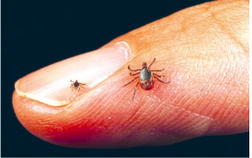If you have an acute tick bite, save the tick after removal and contact the office immediately.
Early treatment can prevent long-term symptoms. See below for more info.
Our approach:
Almost every aspect of Lyme disease is loaded with controversy, from definition to prevalence to diagnosis to treatment. Different organizations offer vastly opposing guidelines for medical providers. At Integr8 Health, we strive to critically evaluate and understand the science behind all Lyme recommendations. We then apply this information intelligently to our patients and create individualized diagnoses and treatment plans that are best for them. We make use of many modalities, including antibiotics, herbal protocols, detoxification strategies, immune support, Homeopathy, nutrition, lifestyle changes, Osteopathy, and energy medicine. Our goal is not just to treat active infections, but to restore you to vibrant health. Whether you have had a recent infection, or are trying to rebuild your health after a long term illness, we can help. If you suspect Lyme may be a component of your current health challenges, contact our office for a Lyme disease consult now. Our expert providers have devoted significant training and study to the identification and treatment of Lyme and other tick-borne diseases.
Our promise:
- We will listen with respect.
- We will help you find an accurate diagnosis if possible.
- We will explain your options for diagnostic workup and treatment, including risks, benefits, and financial costs.
- We will never tell you that your illness is imagined or impossible, or that there are no treatment options for you. There are always options.
- We will partner with you in creating a plan that addresses your concerns and helps you achieve your optimal level of health.
- Plans will always address infection, detoxification, inflammation, immune health, GI health, nutrition, energy level, sleep, and hormonal health.
What to expect?
During a 60-minute initial Lyme consultation, your provider will:
- Take a detailed history and perform a targeted physical exam to help determine your likelihood of having the infection.
- Discuss the pros and cons of various laboratory tests, and if appropriate, your provider will write a lab order for you.
- Craft a treatment plan to guide you to better health. This will address all components of your illness, such as infections, inflammation, detoxification, digestion, sleep, nutrition, and hormonal balance. Treatments may include pharmaceutical medications, herbal protocols, individualized herbs, homeopathy, supplements, Osteopathic manipulation, and IV therapeutics.
Costs:
- Initial evaluations for chronic Lyme disease evaluations last 1 hour and cost $400. We will take a detailed history and formulate an individualized plan based on your specific situation.
- Follow up visits are scheduled as needed (15-60 minutes) and cost $400/hr
- Visits for acute tick bites for established patients are 15 minutes and cost $100. They are available Monday through Thursday. These vizits include workup and treatment for acute symptoms. We will do our best to see you the same day, but please call first!
- Diagnostic tests range from free (if you have insurance coverage and use in-network labs) to over $1000 for specialty labs.
- Treatments range from very low cost ($20/month) to very high ($800/month for some antibiotics, herbal protocols, and supplements).
- Length of treatment varies from 1 month to several years. It usually depends on how long treatment has been delayed, and how sick someone is.
What is Lyme disease?
Lyme disease is an illness caused both by a bacteria (Borrelia burgdorferi), and our bodies reaction to the bacteria. The illness is divided into three stages: early, disseminated, and late. Usually, when it is identified in the earlier stages, it is a mild infection that is easily treated with antibiotics. When not identified until the later stages, it can become a chronic and debilitating illness. Lyme can affect any and every part of the body, and there is a very wide range range of how people experience the disease. Many people will not experience one of these stages.
There is a lot of controversy about every aspect of this disease. Some of this controversy is because there is still much we don’t know about this disease. Some is purely due to misinformation and confusion. We always attempt to provide as scientifically based and unbiased information as we are able.
Please also note that this information focusses on the transmission and characteristics of Lyme disease in Maine. These can vary by region.
What are the symptoms of Lyme disease?
Early infection:
Early infection is marked by a characteristic skin rash called erythema migrans. It is usually a red circular rash that starts at the site of a tick bite approximately 3 – 14 days later. The rash enlarges slowly, and often the center clears as the edge spreads outward. This gives it a “bull’s eye” appearance. Rashes can vary. Taking photos and marking the edge of the rash can be very helpful. If someone has this rash, it confirms Early Lyme disease and no further testing is needed. In fact, most tests look for antibodies to the bacteria, and they will be negative at this stage.
Early disseminated infection:
Early disseminated infections usually consists of a flu like illness that may include:
- fever and chills
- fatigue
- muscle or joint pains
- headache
- facial weakness and many other more specific symptoms.
Influenza (or “the flu”) is very uncommon in the summer and fall. There are accurate rapid tests widely available for the flu that can help rule out Lyme disease if someone has an infection like this in the spring, summer, or fall.
Late (or late disseminated) infection:
Late Lyme disease is the most variable. It can range from being very mild to very serious. It can affect any part of the body including the joints, tendons, ligaments, nerves, brain, heart, and bladder. Two characteristics of Lyme disease that are uncommon in other diseases are:
- Symptoms are often come and go, or worsen and improve with an unusual pattern.
- Symptoms move around to different parts of the body. For example, joint pain can move from right knee to left knee to right hip to left foot.
Common symptoms include:
- severe persistent fatigue
- suddenly feeling a lot older
- joint pains
- worsening of old injuries that seemed healed for many years
- neuropathies, i.e. radiating numbness, tingling, pain, or one sided weakness of areas of the face, arms, or legs.
- problems with memory, concentration, confusion, and sleep.
- mood changes like depression, anxiety, or panic episodes that seem new and out of character.
Lyme disease is very rarely fatal. The exception is that if it affects the heart, it can cause serious complications.
How is Lyme disease diagnosed?
Lyme disease is diagnosed based on a patient’s history, symptoms, and physical exam. It is necessary to be exposed to ticks that carry Lyme, but not to remember a tick bite. Laboratory tests can be extremely helpful. They can support the diagnosis of Lyme disease, but are not required. Because Lyme can vary so widely and mimic other diseases, it is often important to rule out other causes of illness. However, Lyme disease should always be considered for the above symptoms in Maine!
The most common tests (ELISA and Western Blot) look for antibodies that our bodies make to the bacteria (Borrelia burgdorferi). There is an incredible amount of controversy about these tests, including what specific antibodies should be included and what makes a test positive or negative.
There are tests available that look directly for components of the bacteria or grow the bacteria in culture. These tests are more specific and confirmatory of Lyme disease. However, they have varying sensitivities and are often expensive.
Here are some points to keep in mind about testing:
- Erythema migrans (the rash) is confirmatory of Lyme disease and no further testing is necessary.
- Tests taken within 4-6 weeks of a tick bite (or 2-4 weeks of the rash) almost always are negative (excepting biopsies taken of the outside border of the rash).
- Ask your provider to request the details of the report and give them to you. This includes which antibodies (or bands) are positive, equivocal, or negative. Seeing how this pattern changes over time can be as important as the pattern itself.
- Early use of antibiotics may decrease the number of antibodies we make – and thus the sensitivity of the test – without completely treating the infection.
- Tests can be falsely negative.
- Again, there is strong disagreement about these tests.
How is Lyme disease treated?
For Early Lyme disease, a simple course of antibiotics taken by mouth for 4-6 weeks is the mainstay of treatment. It usually resolves the infection completely.
The later Lyme disease is diagnosed and treated, the more complicated it becomes. Antibiotics can be an important part of treatment, but often are only one part. Borrelia like to create an environment inside their host (i.e. humans) that allows it to thrive. This usually includes suppressing our immune systems in some ways and stimulating it in others, promoting inflammation and tissue damage, affecting hormones, digestion, sleep, cognition, and mood. Healing must repair and reverse these changes if it is to be lasting. Drawing on conventional, alternative, and integrative medicine provide us with multiple strategies to do this. Treatment plans in advanced Lyme disease should always be personalized and based on a thorough evaluation.
How is Lyme disease spread?
Lyme disease is spread by the bite of infected black legged ticks (also known as deer ticks or Ixodes scapularis). These are very small ticks that attach to humans and other animals and drink our blood. Most studies show that a tick must be attached for at least 24 hours for transmission to occur. At the very least, the tick must have begun feeding and become engorged or swollen. Dog ticks have not been shown to transmit this bacteria. Lyme disease can also be spread from mother to child during pregnancy.
Some people suspect that Lyme disease may be transmitted in other ways, including via sex, breast milk, and other biting insects like black flies or lice. There are plausible mechanisms for these theories, but they have never been proven.
What are co-infections?
Co-infections are other diseases that are transmitted by ticks, often in the same bite. When two or more infections occur at the same time, they can both be more serious than they usually are alone. The two most common and well established co-infections are:
- Babesiosis – caused by a protozoan parasite (usually Babesia microti), that infects red blood cells. Infection can range from very mild to fatal. People without a spleen, who are immunosuppressed, or the elderly, are at the greatest risk for serious infection. Symptoms may include fever, chills, sweats, fatigue, cough, shortness of breath, nausea, vomiting, diarrhea, and abdominal pain. It is similar to malaria.
- Human Granulocytic Anaplasmosis (formerly Ehrlichiosis) – caused by a small bacteria called Anaplasma phagocytophilum that affects white blood cells. Symptoms are not specific and include fever, headache, muscle pain, nausea, vomiting and fatigue. Most cases are mild, but can be serious, especially in the elderly. Changes can show up on routine blood tests (low white blood cells, low platelets, elevated liver enzymes).
Less common co-infections, or those that are still controversial, include Tularemia, Bartonella, Chlamydia, and Mycoplasma.
What should I do next?
Take action! If you suspect Lyme may be a component of your current health challenges, contact our office for a Lyme disease consult now. Our expert providers have devoted significant training and study to the identification and treatment of Lyme and other tick-borne diseases.
How to prevent disease
CHECK YOURSELF AND YOUR CHILDREN EVERY TIME YOU GO OUTDOORS FROM SPRING TO FALL!
Black legged ticks, especially in the nymphal (baby) stages, are small and easy to miss – unless you’re looking! Get naked and check your entire body using your fingers and eyes, especially along the hairline and groin.

Nymphal and adult female black legged ticks.
Ticks can catch a ride inside on your clothing. Ticks can be killed by putting clothes in the dryer on hot for an hour.
There are many strategies to decrease exposure to ticks. These range from wearing appropriate clothing and bug repellant, to designing outdoor play areas to minimize tick habitats. The following links provide good information:
- http://www.ct.gov/caes/lib/caes/documents/publications/bulletins/b1010.pdf
- http://www.tickencounter.org/prevention/identify_and_eliminate_tick_habitat
- http://www.mmcri.org/home/webSubContent.php?list=webcontentlive&id=110&catID=4&subCatID=19
Note: for those of you that cringe at the thought of spraying pesticides on your property or your children, there are botanical alternatives. Some have been studied with good results:
- http://www.atlanticpestsolutions.net/mosquitos-ticks/mosquito-tick-treatment/all-natural-vs-conventional-mosq-tick-treatment).
- www.bearmountainbotanicals.com (One of our patients created this product line, and we have had good anecdotal success with it. It is available in the office).
Ticks are most plentiful in areas where woodlands transition into fields, meadows, or yards. Ticks are often found in tall grass, gardens, or mulch beds. Deer paths through the woods are often loaded with ticks. Leaf litter, wood piles, and rock walls are also areas of high tick concentration. Where deer and/or mice are present, ticks are usually abundant. When you are in such areas, you need to be particularly vigilant to prevent a tick from attaching to your body. Ticks cannot jump or fly. They stick to us when we pass by, then find a warm spot to attach their mouthparts and feed.
What to do if you find a tick attached?
1 – Remove it promptly and properly:
Using fine needle tweezers or a tick removal spoon, grasp the tick on the head as close to the skin as possible, and apply slow, gentle, steady pressure directly perpendicular to the skin (up). It can take up to a minute for the tick to release its bite. It is important to remove the head and NOT to squeeze the belly. Do not burn or suffocate the ticks. After removal, clean the area with soap and water and apply an antiseptic ointment.
Click here for detailed tick removal instructions with a video: http://www.tickencounter.org.
We have tick removal spoons available for free in the office. Pick some up and have them on hand. They are also available at Maine.gov.
2 – Identify the tick:
Black legged ticks are the only ticks in New England believed to carry Lyme disease. (Dog ticks can carry other diseases including Rocky Mountain Spotted Fever). We have tick identification cards available for free in the office. There are large pictures available here:
3 – Send the tick into the University of Massachusetts Laboratory of Medical Zoology:
They will analyze the tick and tell you what disease causing organisms it carries. Tests are 99.9% accurate, and cost $50 for a full panel appropriate to the type of tick. Results are available within 5 business days. This is a not for profit service, and the only one of its kind available in New England. Other labs can identify the tick, but not tell you what diseases it carries. This information is crucial in telling you whether you have been exposed to Lyme disease as well as the other common co-infections (Babesia, Ehrlichia). This can guide antibiotic prophylaxis and treatment. It may also prevent you from having to wait 6 weeks to begin testing for Lyme Disease that can expensive, and is not always accurate.
- www.tickreport.com
- https://extension.umaine.edu/ticks/submit/
4 – If you find an engorged deer tick, please call our office for advice.
We’ll do our best to fit you in ASAP for a quick visit (15 minute visit). There is a wide range of recommendations about the length of time a tick needs to be attached to transmit infection, as well as the appropriate treatment for a tick bite. We can discuss the risks and benefits of the various approaches and help you choose the treatment that is best for you. We offer treatments based on ILADS guidelines (antibiotics) as well as natural treatmnets.
- Take action! If you or your healthcare provider suspects you may have Lyme disease, contact our office for a Lyme disease consult now.
Lyme Disease and Co-Infection information and links:
- Here’s the link to submit ticks to UMass for testing.
UMass Tickborne Disease Diagnostics – Sample Submission
- Lab of Medical Zoology Tick Borne Diseases Passive Surveillance.
You can search by state, zip code, date, species and pathogen and see the stats of the ticks they have studied in a certain area. Very interesting information!
Lab of Medical Zoology – Tick Disease Stats
- This link is awesome. It has large full color pictures of the ticks & in what area they are present and which season. It has lots of other good resources and information. Definitely one to bookmark.
TickEncounter Resource Center Tick I.D. – New England
- Lyme Disease and associated diseases A plain-language introduction to tick-borne diseases THE BASICS
http://www.lymepa.org/Basics_6th_edition_2013-4.pdf
- Tick Management Handbook http://www.ct.gov/caes/lib/caes/documents/publications/bulletins/b1010.pdf
- Psychiatric Lyme Brochure – ILADS
http://www.ilads.org/lyme/lyme-brochure-psych-2014.pdf
- Maine Medical Center Research Institute – Lyme & Vector Borne Disease Info – Tick Prevention & Control
http://www.mmcri.org/home/webSubContent.php?list=webcontentlive&id=110&catID=4&subCatID=19
- Outcomes Important to Lyme Patients
http://lymedisease.org/activism/idsa-guidelines-survey-results.html
- Tick Control Options Questionnaire – Are there ticks on my property & how do I get rid of them? http://www.mmcri.org/lyme/survey/tickhome.php
- Archive: Can foxes reduce the risk of Lyme disease? VIDEO
http://www.poughkeepsiejournal.com/videos/news/health/lyme-disease/2014/10/27/18000483/
- Lyme: Are bacteria (or research) being starved to death? “So, the thinking goes, if you can inhibit the protein that takes up the manganese, perhaps you can starve, or at least degrade, the pathogen.”
Information on Cannabis and Lyme
Note: The use of cannabis to treat Lyme Disease is new and there are not yet any published studies on its efficacy.
Cannabis can be very helpful to control many of the symptoms of Lyme Disease.
- Cannabis Relieves Nerve Pain from Lyme disease, Fibromyalgia, & Associated Conditions
- Amazing Results: The Healing Power of Cannabis Oil On Lyme Disease and Lyme Co-infections
- Cannabis Kicks Lyme Disease to the Curb
http://www.realfarmacy.com/kicks-lyme-disease-to-the-curb/
- What are Cannabis Topicals and how do they work?
https://www.leafly.com/news/cannabis-101/what-are-cannabis-topicals


